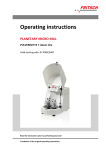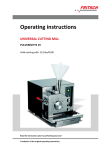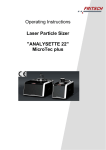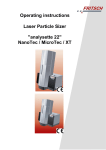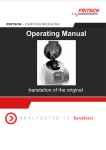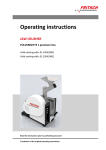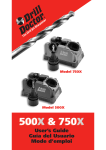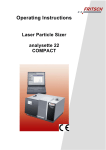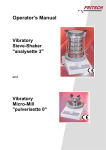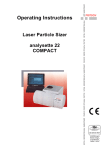Download Operating instructions
Transcript
Operating instructions PARTICLE SIZER ANALYSETTE 28 IMAGESIZER Valid starting with: 28.2000/00100 Read the instructions prior to performing any task! Translation of the original operating instructions Fritsch GmbH Milling and Sizing Industriestraße 8 D - 55743 Idar- Oberstein Telephone: +49 (0)6784/ 70-0 Fax: +49 (0)6784/ 70-11 Email: [email protected] Internet: www.fritsch-sizing.de Version 01/2014 Index 003 Certifications and CE conformity Certifications and CE conformity Certification Fritsch GmbH has been certified by the TÜV-Zertifizierungsgemeinschaft e.V. An audit certified that Fritsch GmbH conforms to the requirements of the DIN EN ISO 9001:2008. CE Conformity The enclosed Conformity Declaration lists the guidelines the FRITSCH instrument conforms to, to be able to bear the CE mark. -3- Table of contents Table of contents 1 Basic structure............................................................................... 6 2 Safety information and use........................................................... 8 2.1 Requirements for the user..................................................... 8 2.2 Scope of application............................................................... 8 2.3 Obligations of the operator................................................... 9 2.4 Information on hazards and symbols used in this manual.... 9 2.5 Device safety information.................................................... 12 2.6 Hazardous points................................................................. 13 2.7 Electrical safety.................................................................... 14 2.7.1 General information......................................................... 14 3 Technical data.............................................................................. 3.1 Dimensions.......................................................................... 3.2 Weight.................................................................................. 3.3 Operating noise.................................................................... 3.4 Voltage................................................................................. 3.5 Current consumption........................................................... 3.6 Power consumption............................................................. 3.7 Electrical fuses..................................................................... 15 15 15 15 15 15 15 15 4 Installation................................................................................... 4.1 Transport and storage.......................................................... 4.2 Unpacking............................................................................ 4.3 Scope of delivery.................................................................. 4.3.1 Accessory case.................................................................. 4.3.2 Accessory tray................................................................... 4.4 Setting up............................................................................. 4.5 Ambient conditions.............................................................. 4.6 Transport securing devices.................................................. 4.7 Electrical connection............................................................ 4.7.1 Stability of the mains voltage............................................ 4.8 Preparation of the ANALYSETTE 28 ImageSizer................... 4.8.1 Connection of the camera to the lens and insertion........ 4.9 Mounting the funnel............................................................ 4.10 Preparation of the computer............................................. 4.11 Checking the communication between the device and the PC................................................................................. 4.11.1 Checking the communication between the camera and the PC.............................................................................. 16 16 16 17 18 18 19 19 19 20 20 21 21 22 23 Using the device........................................................................... 5.1 Changing the lens................................................................. 5.1.1 Adjusting the camera angle.............................................. 5.1.2 Changing the sample guide plate...................................... 30 30 32 32 5 -4- 28 28 Table of contents 5.2 Fritsch test powder F16....................................................... 5.2.1 Filling with material and adjustment of the funnel height................................................................................ 5.2.2 Positioning the feeder....................................................... 5.2.3 Measuring with the ImageSizer........................................ 33 34 35 6 Accessories................................................................................... 6.1 Lenses.................................................................................. 6.2 Computer............................................................................. 6.3 Dust extraction system........................................................ 36 36 36 37 7 Cleaning........................................................................................ 7.1 Cleaning the device.............................................................. 7.1.1 Cleaning the falling chute................................................. 7.2 Cleaning the lens.................................................................. 7.3 Cleaning the windows.......................................................... 7.3.1 Removal of the window holder......................................... 7.4 Cleaning the lens of the digital camera................................ 38 38 38 38 39 39 40 8 Maintenance................................................................................ 41 9 Repairs......................................................................................... 42 9.1 Checklist for troubleshooting............................................... 42 10 Disposal........................................................................................ 44 11 Guarantee terms.......................................................................... 45 12 Exclusion of liability..................................................................... 47 13 Safety logbook............................................................................. 49 14 Index............................................................................................. 52 -5- 33 Basic structure 1 Basic structure The designations below are used with the corresponding numbers in the following operating instructions. 1 2 3 4 Funnel Feed channel Height-adjustable funnel holder Funnel support column 5 6 7 8 -6- Sample collection container Latches Housing flap Base plate Basic structure 9 10 11 12 13 5 MP digital camera Lens holder Lens Lens holder end stop Holder with optical glass window 18 19 20 21 Main switch Ethernet connection Mains connection USB socket 14 15 16 17 22 -7- Holder with frosted Plexiglas window Flash unit Falling chute Sample guide plate Setting ring Safety information and use 2 Safety information and use 2.1 Requirements for the user This operating manual is intended for persons assigned with operating and monitoring the Fritsch ANALYSETTE 28 ImageSizer. The operating manual and especially its safety instructions are to be observed by all persons working on or with this device. In addition, the applicable rules and regulations for accident prevention at the installation site are to be observed. Always keep the operating manual at the installation site of the ANALYSETTE 28 ImageSizer. People with health problems or under the influence of medication, drugs, alcohol or exhaustion must not operate this device. The ANALYSETTE 28 ImageSizer may only be operated by authorised persons and serviced or repaired by trained specialists. All commissioning, maintenance and repair work may only be carried out by technically qualified personnel. Qualified personnel are persons who, because of their education, experience and training as well as their knowledge of relevant standards, regulations, accident prevention guidelines and operating conditions, are authorised by those responsible for the safety of the machine to carry out the required work and are able to recognize and avoid possible hazards as defined for skilled workers in IEC 364. In order to prevent hazards to users, follow the instructions in this manual. Malfunctions that impair the safety of persons, the ANALYSETTE 28 ImageSizer or other material property must be rectified immediately. The following information serves both the personal safety of operating personnel as well as the safety of the products described and any devices connected to them: All maintenance and repair work may only be performed by technically qualified personnel. This operating manual is not a complete technical description. Only the details required for operation and maintaining usability are described. Fritsch has prepared and reviewed this operating manual with the greatest care. However, no guarantee is made for its completeness or accuracy. Subject to technical modifications. 2.2 Scope of application The ANALYSETTE 28 ImageSizer is used for the analysis of the particle shape and size of powders and bulk solids. The particle sizer has an extra-large measuring range of 20 µm to 20 mm! It is therefore an ideal device for uncomplicated quality control in various areas of application. The particle sizer described here is an operations resource for use in industrial environments. This operations resource possesses hazardous live components during operation. -8- Safety information and use 2.3 Obligations of the operator Before using the ANALYSETTE 28 ImageSizer, this manual is to be carefully read and understood. The use of the ANALYSETTE 28 ImageSizer requires technical knowledge; only commercial use is permitted. The operating personnel must be familiar with the content of the operating manual. For this reason, it is very important that these persons actually receive the present operating manual. Ensure that the operating manual is always near the device. The ANALYSETTE 28 ImageSizer may exclusively be used within the scope of applications set down in this manual and within the framework of guidelines put forth in this manual. In case of non-compliance or improper use, the customer assumes full liability for the functional capability of the ANALYSETTE 28 ImageSizer and for any damage or injury arising from failure to fulfil this obligation. By using the ANALYSETTE 28 ImageSizer the customer agrees with this and recognizes that defects, malfunctions or errors cannot be completely excluded. To prevent risk of damage to persons or property or of other direct or indirect damage, resulting from this or other causes, the customer must implement sufficient and comprehensive safety measures for working with the ANALYSETTE 28 ImageSizer. Neither compliance with this manual nor the conditions and methods used during installation, operation, use and maintenance of the ANALYSETTE 28 ImageSizer can be monitored by Fritsch GmbH. Improper execution of the installation can result in property damage and thus endanger persons. Therefore, we assume absolutely no responsibility or liability for loss, damage or costs that result from errors at installation, improper operation or improper use or improper maintenance or are in any way connected to these. The applicable accident prevention guidelines must be complied with. Generally applicable legal and other obligatory regulations regarding environmental protection must be observed. 2.4 Information on hazards and symbols used in this manual Safety information Safety information in this manual is designated by symbols. Safety information is introduced by keywords that express the extent of the hazard. DANGER! This symbol and keyword combination points out a directly hazardous situation that can result in death or serious injury if not avoided. -9- Safety information and use WARNING! This symbol and keyword combination points out a possibly hazardous situation that can result in death or serious injury if not avoided. CAUTION! This symbol and keyword combination points out a possibly hazardous situation that can result in slight or minor injury if not avoided. NOTICE! This symbol and keyword combination points out a possibly hazardous situation that can result in property damage if not avoided. ENVIRONMENT! This symbol and keyword combination points out a possibly hazardous situation that can result in environmental damage if not avoided. Special safety information To call attention to specific hazards, the following symbols are used in the safety information: DANGER! This symbol and keyword combination points out a directly hazardous situation due to electrical current. Ignoring information with this designation will result in serious or fatal injury. DANGER! This symbol and keyword combination designates contents and instructions for proper use of the machine in explosive areas or with explosive substances. Ignoring information with this designation will result in serious or fatal injury. - 10 - Safety information and use DANGER! This symbol and keyword combination designates contents and instructions for proper use of the machine with combustible substances. Ignoring information with this designation will result in serious or fatal injury. WARNING! This symbol and keyword combination points out a directly hazardous situation due to movable parts. Ignoring information with this designation can result in hand injuries. WARNING! This symbol and keyword combination points out a directly hazardous situation due to hot surfaces. Ignoring information with this designation can result in serious burn injuries due to skin contact with hot surfaces. Safety information in the procedure instructions Safety information can refer to specific, individual procedure instructions. Such safety information is embedded in the procedure instructions so that the text can be read without interruption as the procedure is being carried out. The keywords described above are used. Example: 1. Loosen screw. 2. CAUTION! Risk of entrapment at the lid. Close the lid carefully. 3. Tighten screw. Tips and recommendations This symbol emphasises useful tips and recommendations as wells as information for efficient operation without mal‐ function. Further designations To emphasise procedure instructions, results, lists, references and other elements, the following designations are used in this manual: - 11 - Safety information and use Designation Explanation Step-by-step procedure instructions 1., 2., 3. ... ð Results of steps in the procedure References to sections in this manual and relevant documentation Lists without a specific order [Button] Operating elements (e.g. push button, switch), display elements (e.g. signal lamps) ‘Display’ Screen elements (e.g. buttons, function key assignment) 2.5 Device safety information n The particle sizer has been designed from the viewpoint of safety to users; nevertheless, residual hazards cannot be ruled out. n The device may only be used for the purpose described under Ä ‘Scope of application’ on page 8. n Only use original accessories and original spare parts. Failure to observe this instruction can compromise the safety of the machine. n Safe conduct must be strictly observed during all work with the device. n All currently applicable national and international accident prevention guidelines must be complied with. n Do not remove the information signs. DANGER! Explosion hazard! – The device is not explosion-protected! – The device must not be used in electrically conductive, dusty or damp environments. DANGER! Mains voltage – Do not allow any liquids to run inside the device. - 12 - Safety information and use WARNING! The maximum accepted concentration (MAC) levels of the valid safety regulations must be observed. If necessary, ventilation must be provided or the machine must be operated under an extractor hood. NOTICE! Immediately replace damaged or illegible information signs. n Unauthorised alterations will void Fritsch's declaration of conformity to European directives and void the guarantee. n If after reading the operating manual you still have questions or problems, please do not hesitate to contact our technical specialists. 2.6 Hazardous points DANGER! There is a risk of fatal injuries from power surges when cleaning the device. Disconnect the mains plug before cleaning the device. CAUTION! Crushing hazard! When – – – – – – Moving the funnel Closing the device Inserting the holders with the "measuring windows" 13 + 14 Inserting the lenses Mounting the camera Inserting the sample collection container NOTICE! Do not leave any oxidizing parts on the channel or in the funnel - risk of corrosion. - 13 - Safety information and use 2.7 Electrical safety 2.7.1 General information n The main switch separates the device from the power supply on two poles. n Switch off the main switch if the ANALYSETTE 28 ImageSizer is to stand idle for a longer duration (e.g. overnight). In the switched-on state, the switch is illuminated red and the control lamp on the front side blue. - 14 - Technical data 3 Technical data 3.1 Dimensions 84 x 20 x 28 cm (width x depth x height without funnel and feed channel) 3.2 Weight 43,8 kg net 3.3 Operating noise The noise level is up to approx. 78 dB(A). 3.4 Voltage The voltage range is from 100 - 240 V. 3.5 Current consumption The maximum current consumption is 0.2 A (230 V), 0.6 A (115 V) . 3.6 Power consumption The maximum power consumption is 50 W. 3.7 Electrical fuses Micro-fuse 5 x 20 mm 2A slow-blow, 2 pieces The fuses are located inside the mains power socket (19). - 15 - Installation 4 Installation 4.1 Transport and storage DANGER! Do not step under the transport pallet during transport. The ANALYSETTE 28 is delivered in a wooden crate on a pallet. Do not tilt or stack this crate. The ImageSizer must be transported and stored in its packaging and protected from weather and outside influences. Transport over larger distances only in the original Fritsch packaging. We recommend using a forklift or pallet truck for transporting the packed device. WARNING! Improper lifting can lead to personal injury or property damage. The machine is only to be lifted with suitable equipment and by qualified personnel. The guarantee excludes all claims for damage due to improper transport. 4.2 Unpacking Remove the transport packaging as shown in the following illustrations. - 16 - Installation 1. Cut open the straps of the package using side cutters. 2. Remove the staples using an appropriate tool. 3. Lift the lid off. The accessory case and the funnel (1) can now be seen. 4. Remove the surrounding packaging. 5. Take out the accessory case and the funnel. 6. Remove the foam mouldings and lift the ImageSizer from the transport cradle using two persons. NOTICE! Do not use the channel to lift the ANALYSETTE 28 from the transport cradle. For lifting, reach under the base plate (8). If you have ordered the ANALYSETTE 28 ImageSizer with two lenses, you will find the second lens stored vertically next to the ImageSizer in a lens case (a). 4.3 Scope of delivery Please check the delivery against your order! If the delivery is incomplete or damaged, inform the shipping agent immediately and inform Fritsch GmbH within 24 hours. Any claims received later cannot be considered. - 17 - Installation 4.3.1 Accessory case 2 4 5 6 7 8 9 Standard lens 150 - 20000 µm Connection cable Ethernet cable Spoon spatula Optics tissue USB cable USB stick with software, USB driver, operation manual and software manual 10 5 MP digital camera 4.3.2 11 12 13 14 15 16 17 Antistatic cloth Silicate Flat brush Lens brush Soft Pad Assembly gauge block Hex key set Inventory list Accessory tray n Funnel (1) with funnel holder (3) and end cap - 18 - Installation 4.4 Setting up n Place the ANALYSETTE 28 ImageSizer on an even and stable surface in an interior room. NOTICE! Never operate ANALYSETTE 28 ImageSizer while it is standing on the transport pallet! n Make sure that: – all switches / control elements are easy to access; – the USB and Ethernet interfaces are easy to access. n Please store the transport packaging in order that it can be reused if you need to return the product. Fritsch GmbH accepts no liability for damage caused by improper packaging (non-original packaging). 4.5 Ambient conditions WARNING! Mains voltage – The device may only be operated indoors. – The surrounding air must not contain any electrically conductive particles. – Maximum relative humidity 80% for temperatures up to 31 °C, linearly decreasing down to 50% relative humidity at 40 °C. n The room temperature should be between 5 and 40 °C. n Storage and transport is possible between 1 and 40 °C. n If stored or transported below 10 °C, you must wait until the device has warmed up to ambient temperature before switching on. 4.6 Transport securing devices The sample guide plate inside the device (17) is secured with adhesive tape! - 19 - Installation 4.7 Electrical connection DANGER! Provide short-circuit protection! Risk of damage due to short-circuits. – Make sure that the socket is connected to a mains line protected with a residual current circuit breaker. DANGER! Mains voltage! Changes to the connection line may only be made by a qualified person. Before establishing the connection, compare the voltage and current values stated on the type plate with the values of the power supply system to be used. CAUTION! Ignoring the values on the type plate may result in damage to the electrical and mechanical components. CAUTION! Ensure that the mains supply provides a functional device ground connection! 4.7.1 Stability of the mains voltage Instruments with electronic components require a stable supply voltage (+/- 10% deviation). For weak or non-interference free mains supplies (voltage peaks through inductive load changes or switched-mode power supplies), we recommend connecting via a voltage stabiliser and filter (Art. No. 20.6000.00). - 20 - Installation 4.8 Preparation of the ANALYSETTE 28 ImageSizer Open the front flap (7) forwards by lifting up both latches (6). 4.8.1 Connection of the camera to the lens and insertion 1. Remove the caps from the camera and from the screw thread of the lens. Screw the lens hand-tight onto the camera! 2. Connect the camera as shown in the picture. (a) Ethernet connection (b) Power supply connector (c) Process interface connector - 21 - Installation 3. Insert the camera with lens. To do this, hold the lens tilted backwards in the device housing, as shown in the picture, and hook the flat rail runner onto the rail from behind. Then tilt the lens forwards and position it on the rail. The lens holder can be moved back and forth on the rail. NOTICE! Only remove the front cap from the lens once it is located on the rail! 4. Remove the front cap and push the flat rail runner in the direction of the falling chute as far as the end stop. 5. When the flat rail runner is at the end stop, lock it with the knurled screw (b). The lens is recognised automatically by the device and shown in the software. 4.9 Mounting the funnel You will find the funnel (24.0210.10) as described in Ä ‘Accessory case’ on page 18. - 22 - Installation 4.10 1. Loosen the knurled screw of the funnel holder in a counter-clockwise direction. 2. Push the funnel holder (3) over the funnel support column (4) and lock with the knurled screw. 3. Take the black cap (c) from the accessory compartment and push it onto the column end. Preparation of the computer Computers provided by Fritsch GmbH are already equipped with the software you need and can be used directly after the device has been connected. System requirements: – Intel Core i7 Quad Core processor or equivalent – Minimum of 8 GB system memory – Primary drive: minimum of 256 GB SSD – Secondary drive: 1 TB HDD – NVIDIA graphics card – Additional gigabit network interface card for the GigE camera with support for JumboFrames (e.g. Intel Pro 1000) – USB port – 22" monitor with 1920 x 1080 pixels resolution or better Software: – Windows 7 or higher – Adobe PDF reader 1. Insert the supplied USB stick into the USB port on your PC provided for this purpose. 2. Select the USB stick and run the CD_Start application on this. 3. Select the ANALYSETTE 28. - 23 - Installation 4. Select ImageSizer. 5. Install the 64-bit version of the USB driver. (If you have already installed the newest FTDI-USB driver on your system, you do not need to install this in addition.) 6. Then install the camera driver. 7. Following this, connect the ImageSizer to the PC using the supplied USB cable (26)! NOTICE! When connecting the USB cable, make sure that the USB plug is in the correct position. Connecting the cable incorrectly to the ANALYSETTE 28 can result in property damage or a connection problem with the PC. 8. Make an Ethernet connection between the ImageSizer and the additional PC network interface card using the supplied Ethernet cable! Ensure that the second network interface card is con‐ figured with a fixed IP (192.x.x.x or 169.x.x.x). For any questions about configuring your network interface card, please contact your system administrator. The pictures produced by the camera are sent to the PC via the Ethernet connection. - 24 - Installation 9. Install the Image Sizing Software (ISS). 10. Select a language for the installation. 11. A welcome window for the "Image Sizing Software" Set-up Wizard opens. Click on "Next" to continue the installation. 12. The default target folder for the installation is C:\Program Files. Click on "Next" to continue the installation. - 25 - Installation 13. You can now start the installation by clicking on the "Install" button. 14. Finish the installation by clicking on "Close". 15. A FRITSCH ANALYSETTE 28 icon "ISS.exe" has now been placed on the desktop. - 26 - Installation 16. To start the program without the desktop icon, proceed as follows: n Start Windows Explorer. n The target folder shown during the installation contains the folder "Fritsch GmbH". n In this folder, open the folder "Image Sizing Software". n This "Image Sizing Software" folder contains the file "ISS.exe", with which the program can be started manually! Double-click on the file "ISS.exe" to start the program. After initially starting the software you must specify the memory location for the measuring data. - 27 - Installation 4.11 Checking the communication between the device and the PC You have the possibility in the Image Sizing software to check whether the device has been recognised by the PC and which COM port it is installed on. Proceed as follows: 1. Click on the icon "ISS.exe" to start the Image Sizing software. 2. Click on ‘Configuration’ to go to the configuration settings. 3. In the left part of the screen, the software opens a new window with the various configuration options. Click on ‘Select device’ . 4. In this window, the interface used and the attached device with specifications are shown automatically. If no device is displayed, click on ‘Search’ . This should list all detected devices which are connected to the system. Clicking on a device selects it as the current device and the software is restarted. If no device is found, check whether the device is switched on. If so, check the used drivers and right connections of the used ports on your PC and device. 4.11.1 Checking the communication between the camera and the PC 1. Click on the icon "ISS.exe" to start the Image Sizing software. 2. Click on ‘Configuration’ to go to the configuration settings. - 28 - Installation 3. In the left part of the screen, the software opens a new window with the various configuration options. Click on ‘Measurement settings’ . 4. Then, click on ‘setup’ next to "Detect optimal camera settings". 5. When the camera has been recognized, you can test the image transfer and the camera function by holding a brush or pencil in the falling chute, whereby the object will be displayed in the "Camera Set-up" window. 6. If this is the case, then the communication between the camera and the PC is functioning correctly. If no image is received from the camera, this can have various causes. Check the IPs and subnet masks entered under "Interface" and "Camera". The two IPs must correspond to the subnet masks. (In the example shown: 192.160.100.x) The IP entered under Interface must correspond to the IP of the network interface card that the camera is connected to. To avoid problems with the initial start‐up, connect the ANALYSETTE 28 to the PC and install the software before connecting the system to a LAN. - 29 - Using the device 5 Using the device Soiling of the glasses/windows can lead to incorrect meas‐ urement results. It is therefore essential that these be cleaned. The windows should be checked for soiling after every measurement. Depending on the type of sample, the lens, the windows and the digital camera lens must be checked for soiling before each measurement or measurement series and cleaned if necessary. Also, if smearing or permanent dots can be seen in the picture transmitted by the camera during camera adjustment or when making a measurement, the components mentioned must be checked and cleaned, as described in Ä ‘Cleaning’ on page 38! The Soft Pad (34) provided is intended to protect the top surface of the housing should anything be placed upon it. 5.1 Changing the lens The camera can be left connected to the cables while changing the lens. The lens is recognised automatically by the device and shown in the software. - 30 - Using the device 1. Open the front flap forwards by lifting up both latches (6). 2. Loosen the knurled screw on the flat rail runner and pull the runner backwards away from the falling chute. 3. Place the cap on the lens. 4. Tilt the lens backwards and remove the flat rail runner upwards. 5. Unscrew the lens from the camera, attach the rear lens cap and store in the accessory case. - 31 - Using the device 6. 5.1.1 Now, as described in Ä ‘Connection of the camera to the lens and insertion’ on page 21, connect the other lens to the camera and place it in the device. Adjusting the camera angle The lenses are preassembled with the holders in such a way that all that is left to do is screw them to the digital camera. If, nevertheless, a lens is twisted out of position, it is possible to correct this: 1. Attach the camera to the lens. 2. Remove the 2 hexagon screws closest to you. 3. Turn the lens until the camera is once again correctly aligned with the lens. 4. Once this position has been found, fix the lens in place again with the two hexagon screws. Make sure that the setting ring lies flush against the right holder. 5. 5.1.2 Now the lens is positioned correctly in the lens holder. Changing the sample guide plate To ensure exact positioning of the material to be measured in the focal range of the lens, the device is provided with the corresponding sample guide plates. The gap width of the sample guide plate must be at least three times the diameter of the material to be measured. Change the guide plates as follows: - 32 - Using the device 1. Open the front flap (7) forwards by lifting up both latches (6). 2. Remove the sample guide plate (17) from its slot as shown in the picture. 3. Slide the guide plate that corresponds to the lens into the device. 5.2 Fritsch test powder F16 5.2.1 Filling with material and adjustment of the funnel height 1. Loosen the knurled screw on the funnel holder and push the holder downwards until the funnel exit is sitting on the feeder (2). 2. Place the sample material in the funnel. 3. Depending on the size of the material to be measured, move the funnel slightly upwards and lock it again with the knurled screw. Depending on the flowing properties and size of the mate‐ rial, a smaller gap (for fine powder with good flowing prop‐ erties) or a larger gap (for coarse material) between the funnel and the feeder is needed. The gap to the feeder should be about three times the maximum diameter of the material. - 33 - Using the device 5.2.2 Positioning the feeder The adjustable feeder positioning gives you another way of feeding the sample material to the system optimally in the focal range. You can change the position of the feeder as follows: 1. Remove the sample guide plate and insert the assembly gauge block in the opening of the falling chute. 2. Loosen the four hexagon socket-screws on the feeder. 3. Depending on the starting position, move the channel towards the falling chute or towards the funnel support column (4). 4. Pay attention to the assembly gauge block while securing the feeder in place. This should lie parallel to the feeder. 5. Re-tighten the four hexagon socket screws. After positioning the feeder and while initially feeding in the sample, note how the sample is fed to the falling chute. If the sample flows on one side of the channel, tighten the hexagon socket screws a little until the sample falls properly across the entire width of the feeder into the falling chute. The feeder must be positioned according to the par‐ ticle size and property of the sample. The optimum position of the feeder should be determined through experimentation. - 34 - Using the device 5.2.3 Measuring with the ImageSizer You can check the precision and accuracy of your device by measuring the Fritsch test powder at least once a week, depending on how often you use the device. This will indi‐ cate contamination or malfunctions in your system. Measure the supplied Fritsch test powder F16 with the ANALYSETTE 28 ImageSizer as follows: 1. Set the device to I (On) with the main switch. 2. Start the Image Sizing software. 3. Create a new folder in the archive. 4. A "New Project Case" must be created In the newly created folder. 5. In this project case you can select the SOP "F16 Standard measure" by clicking on "New measurement". SOP refers to a Standard Operating Procedure used in our software. In an SOP, work steps are pre‐defined and processed with a single keystroke. Ensure that you select the SOP which is suitable for your device. 6. The measuring window with the live image, camera and flash settings opens. 7. The particle density thresholds are also displayed and, if necessary and depending on the setting in the SOP, you can still vary the feeder intensity. If the threshold is in the green area, you can start the measurement. 8. Once the cancellation criteria "Image count" or "Particle count" are reached, the measurement is finished and you can display the evaluation by clicking on "Stop" and "Close. 9. When the measurement is finished, remove the sample from the collecting vessel and clean the parts that come into contact with the samples before you begin to measure other materials. - 35 - Accessories 6 Accessories Operating instructions for the optional accessories, such as computer, dust extraction system, colour inkjet printer or laser printer, can be found in the packaging of the respective device. 6.1 Lenses 1. The standard lens provided is the bi-telecentric lens for particle sizes of 150 - 20000 µm. (28.2011.00) 2. Bi-telecentric lens for a measuring range of 58 - 7400 µm. (28.2012.00) 3. Bi-telecentric lens for a measuring range of 20 - 2700 µm. (28.2014.00) 4. Bi-telecentric lens for a measuring range of 28 - 3500 µm. (28.2013.00) 6.2 Computer Computer incl. monitor for ANALYSETTE 28 with keyboard and Windows. (Art. No.: 83.5641.00) - 36 - Accessories 6.3 Dust extraction system Dust extraction system for dust categories "M" (Art. No.: 43.9050.00) and "H" (Art. No.: 43.9010.00). - 37 - Cleaning 7 Cleaning Depending on the type of sample, the lens, the windows and the digital camera lens must be checked for soiling before each measurement or measurement series and cleaned if necessary. Also, if smearing or permanent dots can be seen in the picture transmitted by the camera during camera adjustment or when making a measurement, the components mentioned must be checked and cleaned, as described in Ä ‘Cleaning’ on page 38! 7.1 Cleaning the device DANGER! Mains voltage! – Before beginning with cleaning work, disconnect the mains plug and protect the device against being unintentionally switched back on! – Do not allow any liquids to flow into the device. – Indicate cleaning work with warning signs. – Put safety equipment back into operation after cleaning work. When switched off, the device can be cleaned using a moist cloth or a microfibre cloth. 7.1.1 Cleaning the falling chute First remove the sample guide plate (17). Remove residual material from the falling chute (16) using the brush (32)! 7.2 Cleaning the lens Clean the front and rear lens elements using the lens brush (33). In case of heavy soiling, use the antistatic cloth (30) to remove dirt from the lenses. For cleaning the lens, a separate description from the man‐ ufacturer is provided in the accessory case. These instruc‐ tions must be closely observed! - 38 - Cleaning 7.3 Cleaning the windows The optical glass window (13) and the Plexiglas window (14) require no special cleaning measures. It is sufficient to rinse them with water and allow them to dry, or to clean them with the optics tissue (25) provided in the accessory case. During insertion, ensure that the optical glass window (13) is inserted between the falling chute (16) and the lens (11), and the frosted Plexiglas window (14) between the falling chute (16) and the flash unit (15). 7.3.1 Removal of the window holder The holders for the two windows are attached to the falling chute by four magnets each. Holder with optical glass window 1. To remove the holders, simply tilt the handle of the holder forwards. 2. In this way, the magnets are released and the holders can be pulled out. 3. On reinsertion, the magnetic attraction ensures correct positioning. - 39 - Cleaning Holder with frosted Plexiglas window 1. The Plexiglas window is removed in the same way as the optical glass window. 2. Also proceed in the reverse manner when reinserting. 7.4 Cleaning the lens of the digital camera If smearing or fixed dots can be seen on the picture transmitted by the camera, all components must be checked! If the windows and the lens have been cleaned, but the soiling is still visible, check the camera by turning it. If the soiling moves in the turning direction of the camera, the soiling must be on the glass cover of the sensor. CAUTION! On no account may the camera lens be put under mechanical stress during cleaning. The lens must be cleaned using the lens brush (33) and the optics tissue (25) located in the accessory case. - 40 - Maintenance 8 Maintenance DANGER! Mains voltage – Before beginning with maintenance work, unplug the mains plug and protect the device against being unintentionally switched back on again! – Indicate maintenance work with warning signs. – Maintenance work may only be performed by specialised personnel. – Put safety equipment back into operation after maintenance or repair work. The ANALYSETTE 28 ImageSizer is - with the exception of regular cleaning - maintenance-free. We recommend keeping a safety logbook Ä Chapter 13 ‘Safety logbook’ on page 49, where all work (maintenance, repairs......) performed on the device is entered. - 41 - Repairs 9 Repairs DANGER! Mains voltage! – Before beginning with repair work, unplug the mains plug and protect the device against being unintentionally switched back on. – Indicate repair work with warning signs. – Repair work may only be performed by specialised personnel. – Put safety equipment back into operation after maintenance work. 9.1 Checklist for troubleshooting Fault description Cause Remedy "ANALYSETTE 28 device not found"; "Camera not found" USB cable not connected Remove the USB cable and make sure that the correctly! USB plug is in the correct position when reconnecting it. Start the software again! Ethernet cable not connected correctly! Check Ethernet cable and connect it properly to the device and PC! Start the software again! Main switch at 0 (OFF) Switch on main switch. No mains connection Plug in mains plug and switch on the device! Particle density during measurement Too much sample mateis too high rial is being fed Reduce the feed rate (see "ISS" software manual) Gap between funnel and feeder too large Lower the funnel! Reduce the gap between the funnel and feeder. (see Ä ‘Filling with material and adjustment of the funnel height’ on page 33) Lens for wrong measuring range used Insert lens for the required measuring range Material is not distributed in the focal range Insert smaller sample guiding plate or align the feeder optimally Blurred images Lens installed incorrectly Push lens forward as far as the end stop of the lens holder and screw it tight. (see Ä point 5 on page 21) While setting the camera in the "Measurement settings" configuration item, a black image is shown. Device was not recognised - 42 - Search for the device in the "device selection" configuration item and select it! (see point 1 "ANALYSETTE 28 device not found"; "Camera not found") Repairs Fault description Cause Remedy USB cable not connected Check USB cable and connect it properly to the correctly device and PC! Start the software again! Protective lens cap not removed Remove protective lens cap (see Ä point 4 on page 21) Camera not connected correctly Check the camera connections! Start the software again! (see Ä point 2 on page 21) No commands executed by the A28! USB cable not connected Check USB cable and connect it properly to the correctly device and PC! Start the software again! No settings can be made in the feeder 'setup' USB cable not connected Check USB cable and connect it properly to the correctly device and PC! Start the software again! Dots are visible in the same places in Soiled windows, lens or all images camera lens Clean these parts as described in Ä ‘Cleaning’ on page 38! Dark corners are visible in the preview image while setting up the camera Optimise camera settings (gain, gamma, flash) Camera settings not correctly adjusted - 43 - Disposal 10 Disposal It is hereby confirmed that FRITSCH has implemented the directive 2002/95/EC of the European Parliament and Council from 27th January 2003 for the limitation of the use of certain dangerous substances in electrical and electronic devices. FRITSCH has registered the following categories according to the German electrical and electronic equipment act, section 6, paragraph 1, clause 1 and section 17, paragraphs 1 and 2: Mills and devices for the preparation of samples have been registered under category 6 for electrical and electronic tools (except for large stationary industrial tools). Analytical devices have been registered under category 9, monitoring and control instruments. It has been accepted that FRITSCH is operating only in the business-tobusiness area. The German registration number for FRITSCH is WEEE reg. no. DE 60198769 FRITSCH WEEE coverage Since the registration of FRITSCH is classified for bilateral transactions, no legal recycling or disposal process is described. FRITSCH is not obliged to take back used FRITSCH devices. FRITSCH declares it is prepared to take back used FRITSCH devices for recycling or disposal free of charge whenever a new device is purchased. The used FRITSCH device must be delivered free of charge to a FRITSCH establishment. In all other cases FRITSCH takes back used FRITSCH devices for recycling or disposal only against payment. - 44 - Guarantee terms 11 Guarantee terms Guarantee period As manufacturer, FRITSCH GmbH provides – above and beyond any guarantee claims against the seller – a guaranty valid for the duration of two years from the date of issue of the guarantee certificate supplied with the device. Within this guarantee period, we shall remedy all deficiencies due to material or manufacturing defects free of charge. Rectification may take the form of either repair or replacement of the device, at our sole discretion. The guarantee may be redeemed in all countries in which this FRITSCH device is sold with our authorisation. Conditions for claims against the guarantee This guarantee is subject to the condition that the device is operated according to the instructions for use / operating manual and its intended use. Claims against the guarantee must include presentation of the original receipt, stating the date of purchase and name of the dealer, together with the complete device type and serial number. For this guarantee to take effect, the answer card entitled "Securing of Guarantee" (enclosed with the device) must be properly filled out and despatched without delay after receipt of the device and be received by us within three weeks or alternatively, online registration must be carried out with the above-mentioned information. Reasons for loss of the guarantee The guarantee will not be granted in cases where: n Damage has arisen due to normal wear and tear, especially for wear parts, such as: Crushing jaws, support walls, grinding bowls, grinding balls, sieve plates, brush strips, grinding sets, grinding disks, rotors, sieve rings, pin inserts, conversion kits, sieve inserts, bottom sieves, grinding inserts, cutting tools, sieve cassettes, sieve and measuring cell glasses. n Repairs, adaptations or modifications were made to the device by unauthorized persons or companies. n The device was not used in a laboratory environment and/or has been used in continuous operation. n Damage is present due to external factors (lightning, water, fire or similar) or improper handling. n Damage is present that only insubstantially affects the value or proper functioning of the device. n The device type or serial number on the device has been changed, deleted, removed or in any other way rendered illegible n The above-mentioned documents have been changed in any way or rendered illegible. - 45 - Guarantee terms Costs not covered by the guarantee This guarantee excludes any costs for transport, packaging or travel that accrue in the event the product must be sent to us or in the event that one of our specialist technicians is required to come to your site. Any servicing done by persons not authorised by us and any use of parts that are not original FRITSCH accessories and spare parts will void the guarantee. Further information about the guarantee The guarantee period will neither extend nor will a new period of guarantee begin in the event that a claim is placed against the guarantee. Please provide a detailed description of the type of error or the complaint. If no error description is enclosed, we shall interpret the shipment as an assignment to remedy all recognisable errors or faults, including those not covered by the guarantee. Errors or faults not covered by the guarantee shall in this case be rectified at cost. We recommend reading the operating manual before contacting us or your dealer, in order to avoid unnecessary inconvenience. Ownership of defective parts is transferred to us with the delivery of the replacement part; the defective part shall be returned to us at buyer's expense. NOTICE! Please note that in the event that the device must be returned, the device must be shipped in the original Fritsch packaging. Fritsch GmbH denies all liability for any damage due to improper packaging (packaging not from Fritsch). Any enquiries must include a reference to the serial number imprinted on the type plate. - 46 - Exclusion of liability 12 Exclusion of liability Before using the product, be sure to have read and understood this operating manual. The use of the product requires technical knowledge; only commercial use is permitted. The product may be used exclusively within the scope of applications set down in this operating manual and within the framework of guidelines put forth in this operating manual and must be subject to regular maintenance. In case of non-compliance, improper use or improper maintenance, the customer assumes full liability for the functional capability of the product and for damage or injury arising from violating these obligations. The contents of this operating manual are subject in entirety to copyright law. This operating manual and its contents may not be copied, further distributed or stored in any form, in part or in whole, without the prior written consent of Fritsch. This operating manual has been prepared to the best of our knowledge and checked for accuracy at the time of printing. FRITSCH GMBH assumes no guarantee or liability whatsoever for the accuracy or completeness of the contents of this operating manual, including but not limited to the implied warranties of merchantability and fitness for a particular purpose, unless liability is expressly prescribed by applicable laws or jurisprudence. FRITSCH GMBH expressly reserves the right to modify and/or update this operating manual without prior notice. The same applies to modifications and improvements to the products described in this operating manual. It is the responsibility of the user to ensure that they have the current version of this operating manual. For more information, please contact your local FRITSCH GMBH distributor or Fritsch GmbH, Industriestr. 8, D-55473 Idar-Oberstein. Not all parts shown here are necessarily installed in the product. The buyer is not entitled to delivery of these parts. If interested, please contact your local FRITSCH GMBH distributor or Fritsch GmbH, Industriestr. 8, D-55743 Idar-Oberstein. FRITSCH GMBH takes the greatest care to ensure that the quality, reliability and safety of your products are continuously improved and adapted to the state of the art. The supplied products as well as this operating manual conform to the current state of the art when they leave the sphere of influence of FRITSCH GMBH. By using the product the customer agrees with this and recognizes that defects, malfunctions or errors cannot be completely excluded. To prevent risk of damage to persons or property or of other direct or indirect damage, resulting from this or other causes, the customer must implement sufficient and comprehensive safety measures for working with the product. - 47 - Exclusion of liability Fritsch GmbH excludes any liability, warranty, or other obligation to compensate for damages, regardless of whether this liability, warranty, or other obligation is explicit or implicit, contractual or arising from unlawful acts or prescribed contractually, by law, or otherwise. In no event shall the buyer be entitled to any compensation from Fritsch GmbH for any special, direct, indirect, coincidental or consequential damage, including but not limited to lost profits, lost savings, lost sales or financial loss of any kind or for compensation of third parties, for downtimes, for lost goodwill, for damage to or replacement of equipment and property, for costs or restoration of materials or goods related to the product or the use of our products, for other damage or injury to persons (including fatal injuries) or similar. The above exclusion of liability is limited by mandatory liability as prescribed by laws or jurisprudence. Liability for negligence is excluded in all cases. No permission is given expressly, implicitly or otherwise for the use of patents, brands or other copyrights. We also assume no liability for copyright infringements or infringements of the rights of third parties arising from the use of this product. Neither compliance with this operating manual nor the conditions and methods used during installation, operation, use and maintenance of the product can be monitored by Fritsch GmbH. Improper execution of the installation can result in property damage and thus endanger persons. Therefore, we assume absolutely no responsibility or liability for loss, damage or costs that result from errors at installation, improper operation or improper use or improper maintenance or are in any way connected to these. - 48 - Safety logbook 13 Date Safety logbook Maintenance / Repair Name - 49 - Signature Safety logbook Date Maintenance / Repair Name - 50 - Signature Safety logbook Date Maintenance / Repair Name - 51 - Signature Index 14 Index Installing the drivers . . . . . . . . . . . . . . . . . . . . . . . 23 Installing the software . . . . . . . . . . . . . . . . . . . . . 23 A Accessory case . . . . . . . . . . . . . . . . . . . . . . . . . . . 18 Accessory tray . . . . . . . . . . . . . . . . . . . . . . . . . . . 18 Accident prevention . . . . . . . . . . . . . . . . . . . . . . . . 8 Adjustment of the funnel height . . . . . . . . . . . . . . 33 Ambient conditions . . . . . . . . . . . . . . . . . . . . . . . 19 Authorised persons . . . . . . . . . . . . . . . . . . . . . . . . 8 L Lens change . . . . . . . . . . . . . . . . . . . . . . . . . . . . 31 M Mounting the funnel . . . . . . . . . . . . . . . . . . . . . . 22 C Changing the sample guide plate . . . . . . . . . . . . . Checking the communication between the camera and the PC . . . . . . . . . . . . . . . . . . . . . . . . . . . . . Checking the communication between the device and the PC . . . . . . . . . . . . . . . . . . . . . . . . . . . . . Cleaning the device . . . . . . . . . . . . . . . . . . . . . . . . . . . . . falling chute . . . . . . . . . . . . . . . . . . . . . . . . . lens . . . . . . . . . . . . . . . . . . . . . . . . . . . . . . . windows . . . . . . . . . . . . . . . . . . . . . . . . . . . Connecting the camera . . . . . . . . . . . . . . . . . . . . O . 32 Opening the front flap . . . . . . . . . . . . . . . . . . . . . 21 . 28 P . 28 Preparation of the ANALYSETTE 28 ImageSizer . . . . 21 . 38 . 38 . 38 . 39 . 21 R Requirements for the user . . . . . . . . . . . . . . . . . . . 8 S Safety information . . . . . . . . . . . . . . . . . . . . . . . . . 9 Safety logbook . . . . . . . . . . . . . . . . . . . . . 49, 50, 51 Scope of delivery . . . . . . . . . . . . . . . . . . . . . . . . . 17 Setting up the device . . . . . . . . . . . . . . . . . . . . . . 19 Skilled workers . . . . . . . . . . . . . . . . . . . . . . . . . . . 8 System requirements . . . . . . . . . . . . . . . . . . . . . . 23 D Disposal . . . . . . . . . . . . . . . . . . . . . . . . . . . . . . . 44 E Electrical connection . . . . . . . . . . . . . . . . . . . . . . 20 Exclusion of liability . . . . . . . . . . . . . . . . . . . . . . . 47 Explanation of signs . . . . . . . . . . . . . . . . . . . . . . . . 9 Explanation of symbols . . . . . . . . . . . . . . . . . . . . . . 9 T Transport and storage . . . . . . . . . . . . . . . . . . . . . 16 Transport securing devices . . . . . . . . . . . . . . . . . . 19 F U Filling with material . . . . . . . . . . . . . . . . . . . . . . . 33 Fritsch test powder Measuring F16 . . . . . . . . . . . . . . . . . . . . . . . . 35 Unpacking the device . . . . . . . . . . . . . . . . . . . . . . 16 W G Warning information . . . . . . . . . . . . . . . . . . . . . . . 9 WEEE . . . . . . . . . . . . . . . . . . . . . . . . . . . . . . . . . 44 Guarantee terms . . . . . . . . . . . . . . . . . . . . . . . . . 45 I Inserting the lens . . . . . . . . . . . . . . . . . . . . . . . . . 21 - 52 - © 2013 Fritsch GmbH Milling and Sizing Industriestraße 8 D - 55743 Idar- Oberstein Telephone: +49 (0)6784/ 70-0 Fax: +49 (0)6784/ 70-11 Email: [email protected] Internet: www.fritsch-sizing.de























































